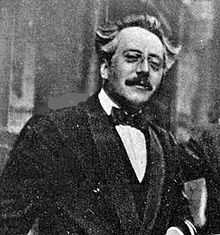Frank Bridge

Frank Bridge (26 February 1879 – 10 January 1941) was an English composer, violist and conductor.
Life

Bridge was born in Brighton and studied at the Royal College of Music in London from 1899 to 1903 under Charles Villiers Stanford and others. He played the viola in a number of string quartets, most notably the English String Quartet (along with Marjorie Hayward), and conducted, sometimes deputising for Henry Wood, before devoting himself to composition, receiving the patronage of Elizabeth Sprague Coolidge.
Bridge had strong pacifist convictions, and he was deeply disturbed by the First World War, after which his compositions, beginning in 1921–24 with the Piano Sonata, were marked by a radical change in musical language (Payne, Hindmarsh, and Foreman 2001). In 1915 he wrote his Lament (for Catherine, aged 9 "Lusitania" 1915), for string orchestra, as a memorial to the sinking of the RMS Lusitania (Cerabona 2014). The piece was premiered by the New Queen's Hall Orchestra, conducted by the composer, on 15 September, at the 1915 Proms, as part of a programme of "Popular Italian music", the rest of which was conducted by Henry Wood (Anon. 1915; Anon. 2014).
Bridge was frustrated that his later works were largely ignored while his earlier "Edwardian" works continued to receive attention (Hindmarsh 1980).
Bridge is mostly remembered for privately tutoring Benjamin Britten, who later championed his teacher's music and paid homage to him in the Variations on a Theme of Frank Bridge (1937), based on a theme from the second of Bridge's Three Idylls for String Quartet (1906). Britten was Bridge's only composition pupil (Template:Hatnb, ); nonetheless, Britten spoke very highly of his teaching, saying famously in 1963 that he still felt he "hadn't come up to the technical standards" that Bridge had set him (Mitchell 1991, ). When Britten left for the United States with Peter Pears in 1939, Bridge handed Britten his Giussani viola and wished him 'bon voyage and bon retour'; Bridge died in 1941 without ever seeing Britten again (Kildea 2013, 149).
Music
Among Bridge's works are the orchestral suite The Sea (1910–11), Oration (1930) for cello and orchestra (recorded in 1976 by Julian Lloyd Webber) and the opera The Christmas Rose (premiered 1932), but he is perhaps most highly regarded today for his chamber music. His early works are in a late-Romantic idiom, but later pieces such as the Third (1926) and Fourth (1937) String Quartets are harmonically advanced and very distinctive, showing the influence of the Second Viennese School (Payne, Hindmarsh, and Foreman 2001). His works also show harmonic influences by Maurice Ravel and, distantly, Alexander Scriabin (Payne, Foreman, and Bishop 1976, 32). One of his most characteristic harmonies is the Bridge chord, for instance C minor and D major sounding at the same time, very poignant in There Is a Willow Grows Aslant a Brook and the Piano Sonata (1921–24). He wrote this work to the memory of Ernest Farrar.
Other frequently performed works are the Adagio in E for organ, Rosemary for piano, and the masterful Cello Sonata in D minor (1913–17). The Scherzetto for cello and piano was rediscovered in the library of London's Royal College of Music by the cellist Julian Lloyd Webber.
Although not an organist himself, and not personally associated with music of the English Church, his short pieces for organ have been among the most-performed of all his output (Hindmarsh 1980).
Works
Bibliography
- Anon. 1915. "Concerts. &c" (classified advertisement). The Times, issue 40960 (Wednesday, 15 September): 1.
- Anon. 2014. Seasons: 1915 Season". Proms 2014: 18 July – 13 September. BBC Radio 3 website (accessed 27 June 2014).
- Cerabona, Ron. 2014. "Pianists Celebrate Wartime Composers". Canberra Times (8 May).
- Hindmarsh, Paul. 1980. Liner notes for The Organ Music of Frank Bridge. Stuart Campbell, organ. (LP Recordig, 1 disc) Pearl SHE 545. Kent: Pearl Records.
- Kildea, Paul. 2013. Benjamin Britten: A Life in the Twentieth Century. London: Allen Lane. ISBN 9780141924304 (pbk); ISBN 9781846142321. Reprinted, London: Penguin Books, 2014. ISBN 9781846142338 (pbk).
- Mitchell, Donald (ed.). 1991. Letters from a Life: The Selected Letters and Diaries of Benjamin Britten 1913–1976, assistant editor Philip Reed; associate editors Rosamund Strode, Kathleen Mitchell, and Judy Young. Vol. 1: 1923–1939. London: Faber and Faber. ISBN 9780571152216.
- Payne, Anthony, Lewis Foreman, and John Bishop. 1976. The Music of Frank Bridge. London: Thames Publishing. ISBN 9780905210025.
- Payne, Anthony, Paul Hindmarsh, and Lewis Foreman. 2001. "Bridge, Frank". The New Grove Dictionary of Music and Musicians, second edition, edited by Stanley Sadie and John Tyrrell. London: Macmillan Publishers.
Further reading
- Little, Karen R. 1991. Frank Bridge: A Bio-Bibliography. Bio-Bibliographies in Music 36. New York, Westport, CT, and London: Greenwood Press. ISBN 9780313262326.
- Payne, Anthony. 1984. Frank Bridge: Radical and Conservative. Published in conjunction with the Frank Bridge Trust. London: Thames Publishing. ISBN 9780905210254.
- Pirie, Peter J. 1971. Frank Bridge. London: Triad Press. ISBN 9780902070028.
External links
- The Lied and Art Song Texts Page created and maintained by Emily Ezust Original texts of the songs of Bridge translated in various languages.
- Free scores by Frank Bridge at the International Music Score Library Project
- Barnett, Rob. "Frank Bridge (1879–1941): Composer, Courageous Revolutionary and Pacifist". MusicWeb International (Accessed 8 November 2012).
- Frank Bridge pages Includes catalogue of works, selective discography, biography
- Frank Bridge-sound-bites and discussion of several of chamber music works
- "Title index to songs and shorter instrumental works published by Thames Publishing". The Frank Bridge Bequest. Retrieved 17 February 2008. Supplements the above list of major works.
- 'Britten and Bridge', lecture and performance investigating the relation between the two composers, Gresham College, 5 February 2008 (available for download as text, audio or video file).
- Frank Bridge: A Life in Brief by Trevor Bray Biography and complete list of works
- Frank Bridge at bach-cantatas.com, with a selection of images of Bridge
 "Bridge, Frank". Encyclopædia Britannica (12th ed.). 1922.
"Bridge, Frank". Encyclopædia Britannica (12th ed.). 1922.
|